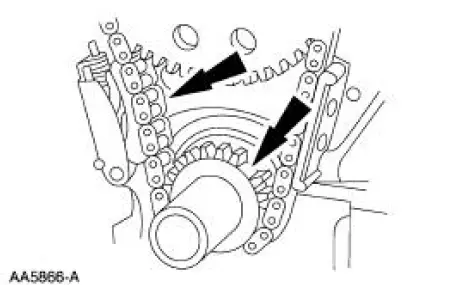Ford Mustang (1999-2004) Service Manual: Sprockets
1. WARNING: To avoid the possibility of personal injury or damage to the vehicle, do not operate the engine with the hood open until the fan blade has been examined for possible cracks and separation.
NOTE: Specifications show the expected minimum or maximum condition. Refer to the appropriate section in Group 303 for the procedure.
NOTE: If a component fails to meet the specifications, it is necessary to install a new component or refinish. If the component can be refinished, wear limits are provided as an aid to making a decision. A new component must be installed for any component that fails to meet specifications and cannot be refinished.
Inspect the timing chain/belt and the sprockets.
- Install new components as necessary. Refer to the appropriate section in Group 303 for the procedure.

Rocker Arms - Cleaning
1. Clean all parts thoroughly. Make sure all oil passages are open.
2. Make sure oil passage in the push rod/valve tappet end of the rocker arm (6564) is open.
 Component Tests
Component Tests
Engine Oil Leaks
NOTE: When diagnosing engine oil leaks, the source and location of
the leak must be positively
identified prior to repair.
Prior to carrying out this procedure, clean all sealin ...
 Rocker Arms - Inspection
Rocker Arms - Inspection
CAUTION: Do not attempt to true surfaces by grinding. Check the
rocker arm pad, side
rails and seat for excessive wear, cracks, nicks or burrs. Check the rocker
arm seat bolt for
stripped or bro ...
Other materials:
Lifting
CAUTION: Do not allow the lift adapters to contact the steering
linkage, suspension arms,
stabilizer arms, or to compress the lower suspension arm stabilizer bar
insulator (5493).
Damage to the suspension, exhaust and steering linkage components may occur i ...
Front Bumper
Special Tool(s)
Heavy-Duty Riveter
501-D011 (D80L-23200-A)
Removal and Installation
All vehicles except Cobra
1. Remove the front bumper cover. For additional information, refer to Front
Bumper Cover in this
section.
Cobra
2. Remove the charge ...
Brake Caliper Anchor Plate - Cobra
Removal
1. Remove the pads. For additional information, refer to Brake
Pads-Cobra in this section.
2. Remove the anchor plate bolts.
Installation
1. Follow the removal procedure in reverse order.
...
